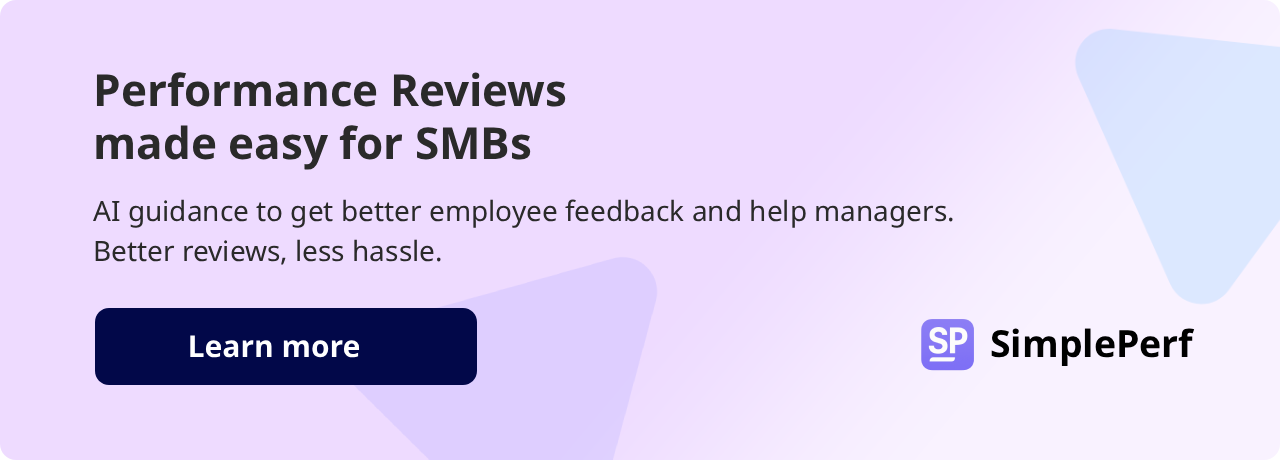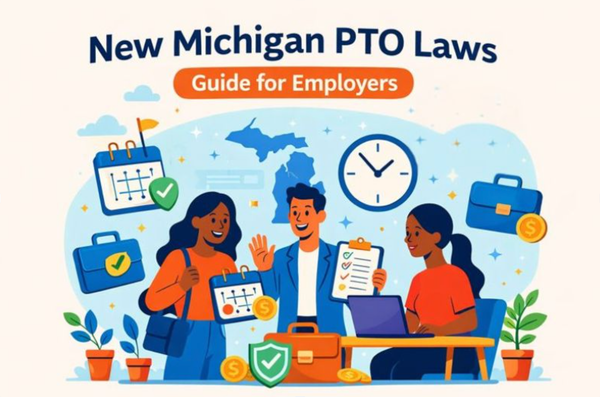Self Review - How to write a performance review for yourself (with examples)
Learn how to write a self-review for your performance evaluation with clear steps, examples, and tips to showcase your strengths and growth areas.

It’s review time, and your manager has asked you to do a self-evaluation as part of the performance review process. But now you’re stumped. You have no idea where to start writing an effective self-assessment. Don’t panic.
We’ll help you write a performance review for yourself, and ace it! We’ll take you through the key skills you should cover, how to put your evaluation forward as a fair assessment of your job performance, and talk about your accomplishments without sounding like a brag.
Key Takeaways: Writing a strong, yet balanced, self-evaluation is an important part of your professional development. It shows your ability to be realistic about your strengths and your development areas, and provides your manager with insights they may not know about. In short, it’s your opportunity to advocate for your progress.

How to write a strong self-evaluation (step-by-step)
According to a Harvard Business Review, 47% of the companies that conduct regular performance reviews use this process; therefore, learning how to write a good self-evaluation is a skill that will give you a lot of mileage.
1. Analyze how you did vs. performance indicators
This first step begins with looking for your own proof of how you’ve been doing during the review period. Start with the most important evidence, which will be Key Performance Indicators (KPIs) or Objective Key Results (OKRs). If you were given specific targets as part of your job description, then check on how you did versus these targets.
If you’re scratching your head right now because you don’t have a way of measuring these indicators throughout the review period (hey, it happens), then consider solving this problem for your boss before the next evaluation. There are performance review tools out there, like the one from BuddiesHR - Simpleperf - that will help you and your manager track performance and run automated 360-degree assessments, and collect peer reviews. Why not make this suggestion in your next review?
Translate these tangible results into reflections on your performance. Communication skills are very important for this part. Be concise and clear about what you are putting forward. Indirectly, these indicators show your time management skills, problem-solving skills, your ability to prioritize tasks effectively, and your customer service skills, to name a few. Highlight these skills in your summaries.
2. Write a summary of your performance vs. your targets
Once you’ve conducted a performance evaluation based on key indicators, it’s time to write a clear and concise summary. This will set the tone for where you’ll be taking the meeting.
Self-evaluation examples - Achievements & challenges
‘I maintained a 96% customer satisfaction score and reduced churn in my accounts by 15%. I developed a “Quick Wins” guide for new customers, which reduced onboarding time by 40%. I also spearheaded our monthly customer webinar series, which doubled engagement in our online community.’
This summary quickly consolidates everything you want your manager to know, and is the end result of collecting hard data that supports the contribution you made - facts are hard to argue with. Now for the challenges.
‘Mid-year, I received feedback about follow-up delays during a high-volume period. I worked with our operations lead to implement an automated reminder system, which has reduced overdue tasks by 50%.’
Contrary to popular belief, writing about your challenges and development areas doesn’t make you look bad. It makes you look honest and mature. Frame your challenges with a view to showing that you identified them and solved them.
Need more help? Check out 👉 What to say in a performance review as an employee
3. Review soft skills for the past year
360 degree assessments are an excellent source of information about interpersonal skills, stress management skills, and get you used to receiving constructive feedback from your peers (including your manager). Also, more than 85% of all the Fortune 500 companies use the 360-degree feedback process as a cornerstone of their performance management process. [1]
Review the feedback carefully to get the big picture of what it’s like to work with you. Note down what you do well and areas for improvement.
Ok, we see some of your cringing. The thought of your colleagues picking out areas of improvement for you doesn’t make you that excited. But honestly, can you really experience career growth without understanding relationships? Also, try to keep a positive attitude towards it - you may have received positive feedback for your personal and professional development.
For more guidance, check out our article: Top 15 areas of improvement at work for ‘go-getting’ employees. In this discussion, we tap into many of the soft skills that are rated in a 360-degree assessment, and you’ll get some good ideas on how to improve on them.
Self-performance review examples - Soft skill development
‘The peer-to-peer assessment highlighted that I communicate well during one-on-one sessions, but struggle to put my ideas forward in a group setting. Several teammates mentioned how well-received my ideas are when I actively participate. Based on this encouragement, I plan to attend online coaching sessions to help me increase self-confidence before the next evaluation period.’
‘A few colleagues pointed out that I handle stress well during team projects, but that personal frustrations are making me confrontational. I’ve taken this to heart and will attend a course to help me express my concerns in a healthier way.’
‘I am surprised by the multi-rater feedback that I have strong leadership skills. I’ve never seen myself like this. Team members have said I should take charge at team meetings because I know how to get things done. I am very motivated to continue growing in this area.’
Keep focused on personal development in these summaries, and avoid finger-pointing at peers. It's bound to go down badly, even if they are misbehaving. It will sound like tit-for-tat.
For more guidance on how to structure your employee self-assessment, check out our article: 75 effective Performance Review Phrases examples in 2025

4. Write a self-evaluation
Now it's time to write your full employee self-evaluation. These tips will help you structure it in an organized manner.
- Briefly explain the approach you took. For example: ‘I have taken performance indicators, manager feedback, and peer feedback to draw my conclusions.’ This will help you start the evaluation.
- Provide valuable insights by covering all your summaries. List them one-for-one under the categories, performance indicators and soft skills development.
- Create a section for the positive attributes that have emerged and been strengthened during this performance review season.
- Create a section that will focus on professional growth and continuous learning. Speak to what new skills (such as specific technical skills) you’ve identified you need. Also, discuss the support you need to strengthen what you are already good at.
- List innovation solutions you’ve thought of as a result of the feedback, or what you feel might contribute to team success.
5. Create a file for your manager with your review and all evidence
If you work for one of those companies that’s forward-thinking enough to have tools like Simpleperf and Clappy Kudos from BuddiesHR, then you won’t have to do this part. If not, it’s a good idea to put your self-evaluation and all the evidence you collected together for your manager.
Send a copy of this file electronically, a day or two before your performance review. You can also provide paper copies for your manager, if that's preferred. Self-evaluations encourage employees to put forward what they’ve been doing to contribute, so don’t hesitate to package it professionally, which brings us to the next section.
Should you use AI to prepare your self-appraisal comments?
This is becoming a popular question. The answer is: You can use AI to help you write self-appraisal comments, but should you? Now that’s the tricky part. Your evaluation should be as polished as it can be, but it's going to be obvious if that’s not how you normally sound. That may leave the impression that you’re taking shortcuts or want to convey something that’s not accurate.
You could use AI to help you structure your evaluation, analyze information, and provide suggestions for comments, but you should write your own evaluation. The self-evaluation process is about finding out what you think and understanding the degree of your self-awareness. It's not just about presenting polished information to your manager. If the whole thing feels disingenuous, it's going to affect the outcome.
Conclusion
Guess who's about to write a great performance review for yourself? That would be you! Using the basic steps we’ve outlined here, you’ve got everything you need to write your evaluation, or at the very least, you’ve got loads of ideas popping off in your head.
Don’t be intimidated by collecting evidence and writing good, solid summaries that explain your achievements and your development areas. If you follow our tips, you’ll do it in a way that will come across as professional. You’ll subtly state the facts (or not, if you’ve had a really good year) and offer solutions for where you need to improve.
The additional resources will provide even more insightful tips on how you can phrase your comments, so don’t forget those as you prepare. And if you found all the evidence collecting a huge task, or couldn't find peer-to-peer feedback, then suggest BuddiesHR to your manager for the next review period. Hey, no one has time to spend hours on tasks that can be done for you, right?
Try BuddiesHR in Slack if you want a better way for everyone to do performance reviews and have fun while you do them.

References:




